1965 Ford Anglia 105E Broadspeed
Broadspeed is synonymous with racing in the 1960s, including several 105E Anglias. Mike Koskela managed to track down and now own one, which he’s carefully brought back to original Group 5 spec.
Words Jim Jupp, Mike Koskela
Photos Jim Jupp Archive Mike Koskela
Team Broadspeed is a name synonymous with racing in the 1960s, including several 105E Anglias. Mike Koskela is lucky enough to own one of these rare Fords, which he has restored over recent years.
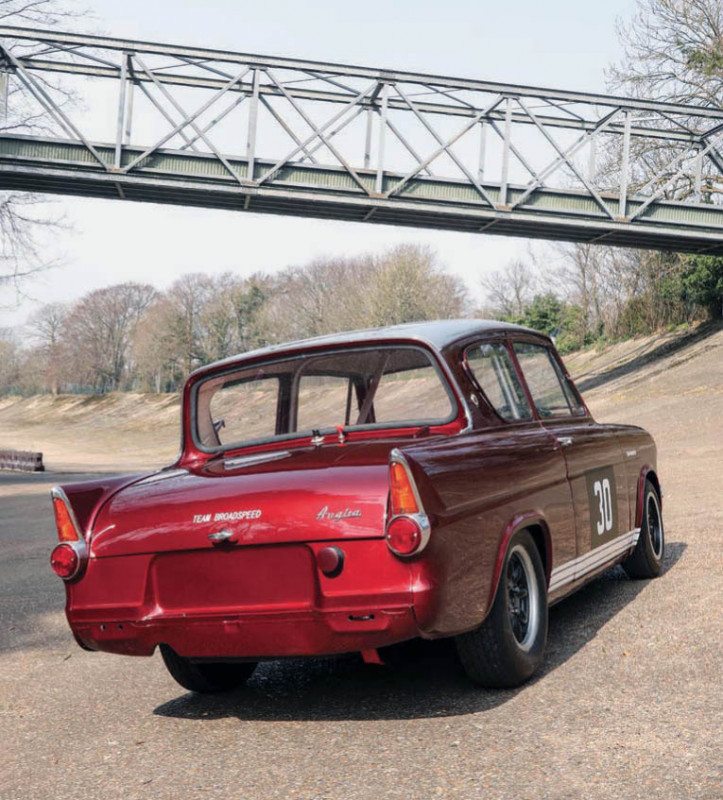
BROADSPEED FORD ANGLIA 105E REAL DEAL
Up until the end of the 1965 racing season, Broadspeed had successfully campaigned BMC Minis. Towards the end of the year Ralph Broad, the owner of Broadspeed, had been approached by Ford’s then competition manager, Henry Taylor and asked if he would be interested in working for Ford, managing the 1-litre Anglia race program. Ralph knew nothing about Anglias, having never worked on one, but a deal was struck. Ford would supply the cars and some financial support, Cosworth would help with engines and Dunlop and Castrol would support with tyres and oils respectively.
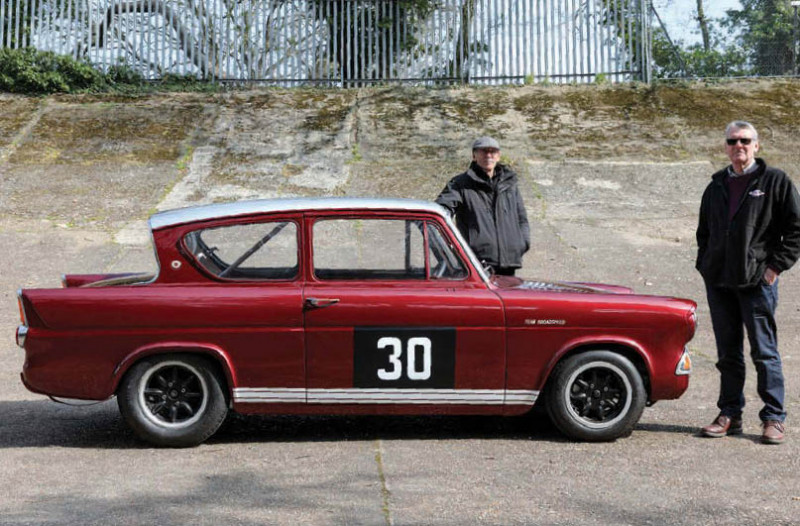
From the time the Anglia was first introduced in 1959 it had been very successful in club racing, but not so in the international classes. This was due to a greater freedom of modifications permitted in club racing over the Group 2 regulations as then used by the British Saloon Car Championship. The Anglia’s main competitors, the Lotus Cortina and the Mini U Cooper S were homologation specials and built with racing in mind, but the Anglia suffered from a lack of homologated parts such as twin carburettors and disc brakes. It was also stuck with lever-arm rear dampers and no proper location of the axle. Allard did homologate the Allardette with front disc brakes, a twin-choke carb and a four-branch exhaust manifold — this being very much being a 1200GT — but it was still no match for the Cortinas and Minis.
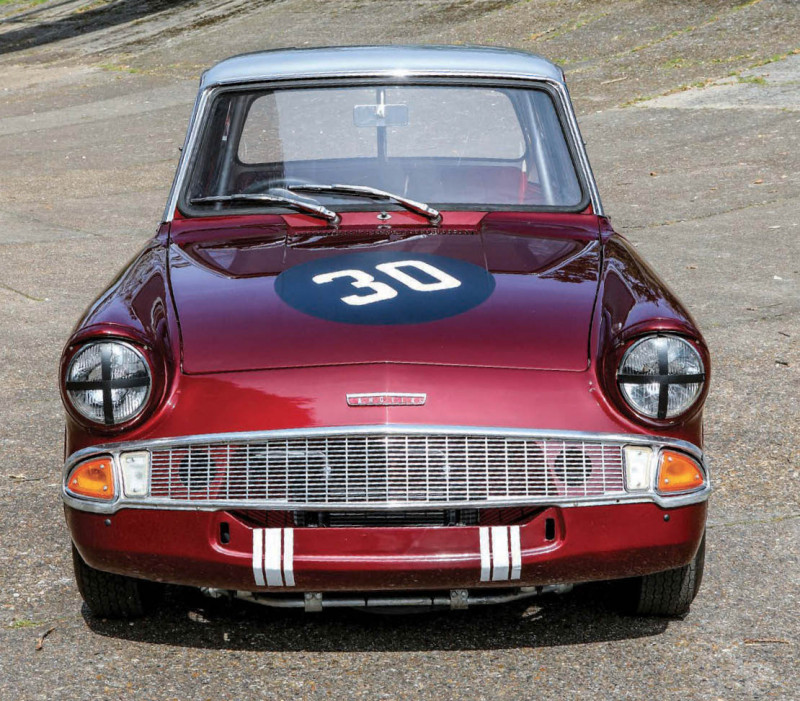
The new Group 5 regulations adopted for the 1966 season, however, changed everything — the regulations allowed far greater freedom for modifying the car over the previous Group 2 regulations. In fact, they were much closer to the club regulations that had made the Anglia so successful over the previous five years. Disc brakes, twin carbs, LSD and a better location of the rear axle — with a Panhard rod or Watts linkage — were now permitted. The Anglia could now race in the 1000cc or up-to-1300cc class. Although the Anglia Super was 1200cc the regulations permitted a capacity increase to the class maximum, in this case the 1300cc class. Ford homologated the five-bearing block for the 1966 season which permitted the use of a five-bearing crankshaft and the full 1300cc.
“PAINTED IN THE TEAM COLOURS OF ROLLS ROYCE REGAL RED WITH A SILVER ROOF, IT’S READY TO GO RACING AGAIN”
The new breed
Under Ralph Broad’s direction, the Broadspeed Anglias were arguably the most successful of the 105E breed, winning the 1966 British Saloon Car Championship with John Fitzpatrick at the wheel. By winning seven of the 10 races in 1967, with only one Did Not Finish (DNF), he again won class D, only this time being pipped to the Championship by Frank Gardener in the Alan Mann Ford Falcon.
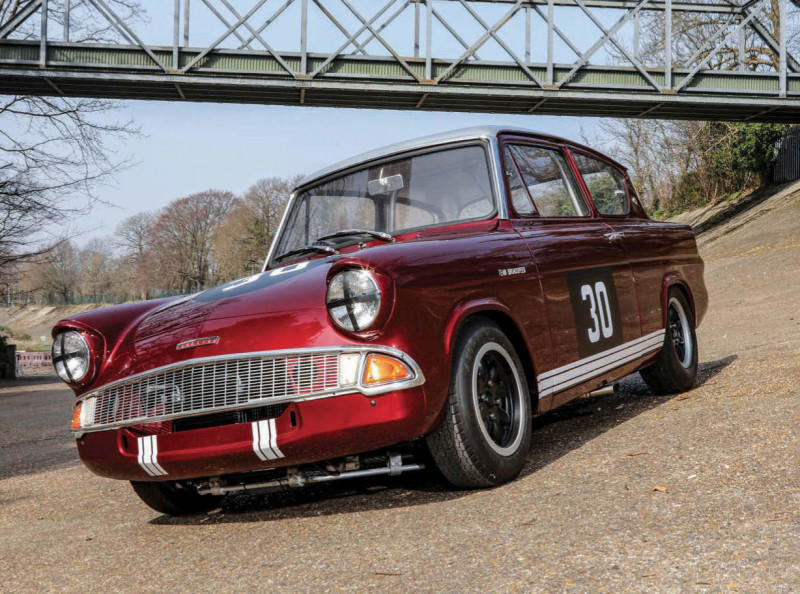
Externally, the Broadspeed Anglias looked pretty much standard from the outside, with the addition of Minilite alloys and a race numbers. Ford supplied Broadspeed with the Anglias complete, which were painted white. Broadspeed would then strip the cars down, carry out the relevant modifications before painting them in their now famous team colours of Rolls Royce Regal Red with a silver roof — and go racing.
Underneath the skin the story is very different. Mike Koskela’s car here was built for the 1967 season with a few changes from the 1966 cars, with the main one being the addition of fuel injection. A reputed 125 bhp and revving to 9500 rpm would make these 997cc engines the most powerful 1-litre production engine until the Cosworth BD-series arrived.
The car you see here on Brooklands’ famous banked track, remained a race car throughout its lifetime, which Mike has been able to trace back to racing in the 1960s (with a possible break in the 1990s) right through until the 2010s. Over the years it slowly evolved into a special saloon gaining the ubiquitous flip front, bubble arches and slicks, and eventually a 2-litre BDG engine. At the end of the 1967 season this Broadspeed Anglia was sold to Rein Zwolsman in The Netherlands where it was painted white with a black and white chequered roof. Rein raced the car in 1968 at circuits such as Zandvoort and Zolder and even a round of the European Touring Car Championship (ETCC) at Monza.
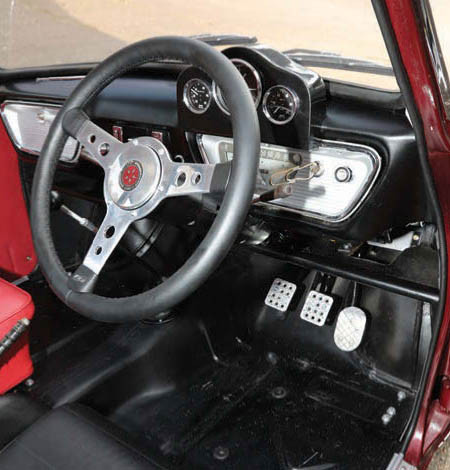
The car then returned to England in 1969 to John Litler, who raced for a couple of seasons at circuits such as Brands Hatch and Snetterton. “I’ve found some video — originally 8 mm cine footage — of John Litler racing the car at Rufforth RAF base in the late 1960s, with the car now painted blue with a white roof and side stripes,” explains Mike.
Mike has spent a great deal of time tracing the car’s history, starting with the chassis number, which showed the car to be manufactured in early 1967, but without a registration number it has been difficult to trace. “One of the other Broadspeed cars was believed to be in South Africa. I located a photo of the car racing in South Africa from around 1969, with a registration beginning UEV, which was an Essex-registered car.” The Essex County records are very complete and Mike was able to locate the original book containing UEV 1-999 numbers. “The car’s chassis number matched with the South Africa car confirming them as two of the 1967 cars. Photos of Rein Zwolsman racing the car in Holland also showing the registration number, UEV 664E confirming the identity of the car.”
Mike has been able to trace the majority of the owners and has gathered an extensive history. A day spent at Pooks Motor Bookshop, trawling through old copies of Autosport unearthed an advert for the Anglia dated March 25, 1971, which enabled him to trace the third owner, who placed the advert, and the fourth owner, Mike Beckett.
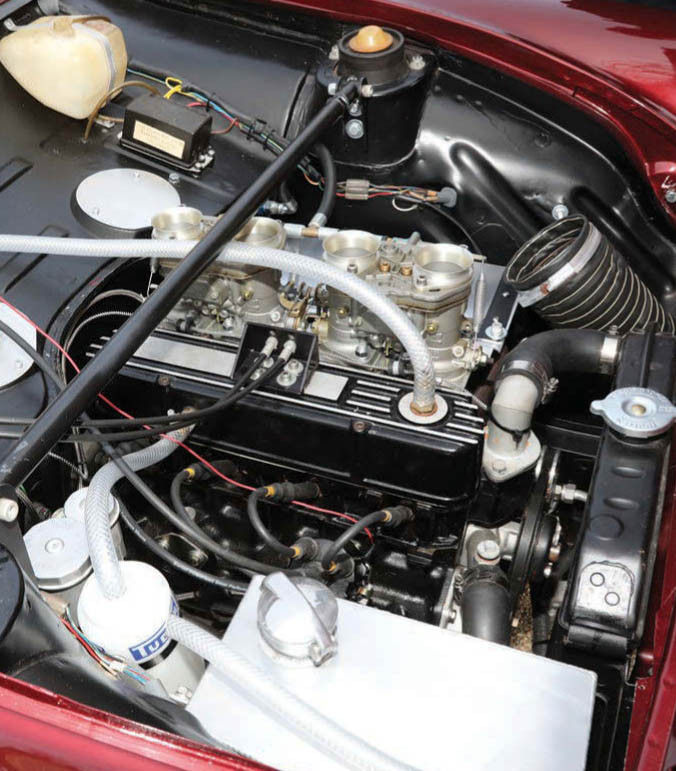
Mike Beckett admits to “cutting it up” and fitting the bubble arches, now almost embarrassed by what he had done. At the time these cars were worth very little and their history was not so relevant. “I feel fortunate to have been able to speak with most of the previous owners, being given period photos and racing anecdotes about its history. Mike Beckett kindly donated the original steering wheel and ignition key complete with an extension piece,” comments Mike.
Mike Beckett sold the Anglia to Jim Stevenson in Ireland, who at some stage fitted a 1-litre BD engine. Sometime in the 1990s the car found its way to Jim Hutchinson, also in Ireland. Jim kindly supplied photos he had of the car in its blue bodywork with a silver arrow on the bonnet, as the car was when purchased, and during its rebuild and in its new red colour scheme.
From there the car returned to England being purchased by Neil Duke and he raced it in the Historic Special Saloon series.
Rightly restored
Mike Koskela acquired the car in 2015 with the aim of restoring it back to its 1967 specification, but unsurprisingly the restoration took longer than anticipated. Covid played a part, but also the extensive list of panels required, as Mike explains, “All the outer panels needed replacing as they had been changed to fibreglass items over time, so sourcing new-old stock panels took a good while.”
Probably the most famous aspect of the Broadspeed Anglias was its rear suspension. First introduced late in the season on the 1966 Fitzpatrick car and carried over on the 1967 cars, the leaf springs were ditched in favour of coilovers in specially welded-in turrets. The axle was located with four links, with the bottom pair picking up in the original leaf spring mounts. Lateral location was by way of a Watts linkage. The set-up was completed with an anti-roll bar. Thankfully, the set-up was still complete when Mike bought the Anglia, and has been retained, but some attention was needed. “The linkage pivot bracket, welded to the rear of the diff casing, was cracked. We had that repaired and other than that it was in good condition. The diff was rebuilt, as it required a different crownwheel and pinion, to suit the smaller engine to be fitted.”
“The front suspension had been changed to an Escort set-up. The original front suspension was very much Lotus Cortinaspec with adjustable dampers and track control arms together with an extra anti-roll bar and disc brakes.” This was fairly straight forward to replace as the parts are still readily available.
The Anglia has been now specced to suit Group 5 regulations, which require that the interior trim and seats remained in place. For the driver, a Restall 5 race seat was fitted and the carpets removed. Additional gauges could be fitted, which Mike has done with a small instrument pod placed on top of the dash which houses a tacho, oil pressure and coolant temperature gauge. Even the front parcel shelf remains in place. A steel John Aley roll cage dominates the interior, with suitably strengthened to the floor and a brace to the rear bulkhead. The windscreen was changed to a laminated type with the remaining glass being changed to polycarbonate, to save weight.
In the 1960s a bag-type fuel tank was used, housed within a fibreglass box cut into the boot floor. The original tank has long gone and now a foam-filled aluminium fuel cell is used.
The engine
The 997cc Anglia engine had been modified over the years with the most popular type being the F3 engine, more commonly known as the Modified Anglia Engine (MAE). The 1967 rules stated that only that the main engine casing needed to be used, with the camshaft to remain in its original position. The cylinder head was modified so that the inlet tract would come in on top of the casing rather than the side (hence the term ‘downdraught head’). This would give a much straighter inlet port giving more power and torque. Other changes included a steel crankshaft and con-rods, forged pistons uprated rocker gear and dry sump lubrication, and this would be the type of engine used in the Broadspeed Anglias. Unfortunately, the original engine expired sometime in the 1970s. The current engine was built for Mike by Joe at Throbnozzle Racing as close to the original specification as possible.
The dry sump tank had previously been changed to a cylindrical-type tank, so Mike made a plywood pattern using a photo of the original tank in the engine bay as a guide. Nick at Garrett Race Fabrications fabricated a replacement in alloy, along with the other fabrication work on the car. In period, the car was fitted with an unsilenced side-exit exhaust, but to comply with modern noise limits Mike had Simpson Exhausts make a suitable silenced system, again with side-exit under the passenger’s door.
Current regulations changes have allowed a lightweight gearbox casings (Lotus Cortina type) to be used by Mike, and a straight-cut, close-ratio gearset with dog engagement to be fitted, with a special five-speed gearset being made by Hewland. A modified crossmember was fitted due to the different mounting type on the Cortina tail housing. As with the gearbox the final drive housing is aluminium and fitted with a limited-slip differential. Wheels are Minilites — 5.5x13 at the front and 6x13 at the rear — fitted with Dunlop 5.00x13 and 5.50x13 CR32 tyres respectively.
The search for more information on this Broadspeed Anglia continues, as does the search for one or two special parts, to bring it closer to its Broadspeed days, as Mike explains: “The engine currently uses Weber carburettors as I’ve not been able to trace the correct fuel injection system. It was manufactured by Tecalemit and Jackson and was of the throttle slide type, so quite rare.” If readers have any leads, then please let us know and we’ll pass it on.
Thanks to: Brooklands Motor Museum, brooklandsmuseum.com
The Anglia’s now back in its original 1967 Team Broadspeed Livery, and it looks absolutely stunning. Foam filled fuel cell replaces the longdeparted fuel bag, mounted in the boot.
Downdraight IDA carbs sit on the specially modified head.
Mike’s hunting for the original Tecalemit-Jackson set-up. Group 5 regs meant Broadspeed could weld in turrets to run proper upright dampers in place of the lever-arm originals.
Brothers, Dave (left) and Mike Koskela have returned the Broadspeed to as close to original as possible.
Mike wonders if this is the white paint used, when
Extra gauges are mounted in a unique pod on the dash. the Anglia was raced by Rein Zwolsman.
Above: Extended key allows the driver to reach the key when strapped in their seat. Top: Restall 5 reserved for the driver with rest of interior retained.
Dry-sumped 997cc engine has been built by Throbnozzle
Racing as close to the original spec as possible.
Side exit exhaust tamed to suit current regulations, but still sounds fruity.
OLD GOLD THE ANGLIA IN-PERIOD
John Fitzpatrick at The Oulton Park Gold Cup meeting in September 1967.
Photo: Mike Hayward collection
Car 45: Rein Zwolsman racing at Zandvoort in The Netherlands, 1968.
Car 115: Mike Beckett at Silverstone in 1971.
Car 147: Mike Beckett again — this time the car has bubble arches.


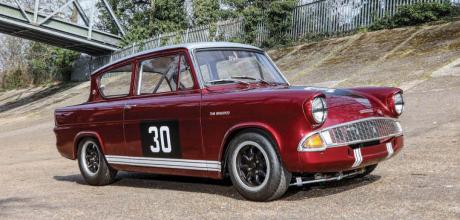
When Broadspeed prepared any saloon car for BMC and later Ford, they firstly stripped the car and having removed all the seam sealer (A laborious process!) seam brazed ALL seams with Magnesium-Bronze brazing rods. This was particularly important with Ford cars as the standard of spot welding in the plant was very poor. (At the time, Ford's «service fix», was to spray silicon oil around duff welds to prevent noises when owners complained about their new car!)
Ralph's focus was upon ensuring that the body shell was as rigid as possible.
It was pointless to design good suspension geometry, if the unit-construction (Monocoque) was floppy!
Magnesium Bronze enjoys a far lower melting point than Silicon Bronze. High temps cause crystalisation of the base metal around the joint and thus weakness.
I worked for Ford Europe (Head Office, Warley, Brentwood, Essex) at this time and in the main entrance foyer was a Team Broadspeed Anglia, on a small stage. It was identical to all the Team Broadspeed Anglias. One small point, the model used was the 107E not the 105E. Interesting times as Ford was using motor sport to promote the brand. GT40s were often seen at Warley and Ford were funding Cosworth to develop the F1 DFV.
When I left Ford, I set up my own automotive business, which included Felspeed Racing. Interestingly, an old chum from my youth and a fellow petrolhead, purchased the show car (he also worked for Ford and managed to engineer a transfer to the competition department at Boreham) and I finished up sorting the ex-Broadspeed Anglia for him. The original lump was removed and sold and a 1650 c.c. engine based on a Lotus twin cam block was used, intended for club racing.
Cut down Transit wheel arches were welded in, in my body shop, to accommodate wide mag wheels an slicks. and the car totally re-finished in Rolls Royce regal red metallic as per standard Broadspeed team colours.
My chum nominated me to take the virgin drive, which took place at Lydden Hill circuit during the TEAC (Thames Estuary Auto Club): At the beginning of the season TEAC rented the circuit for a member's test day.
Happy days...